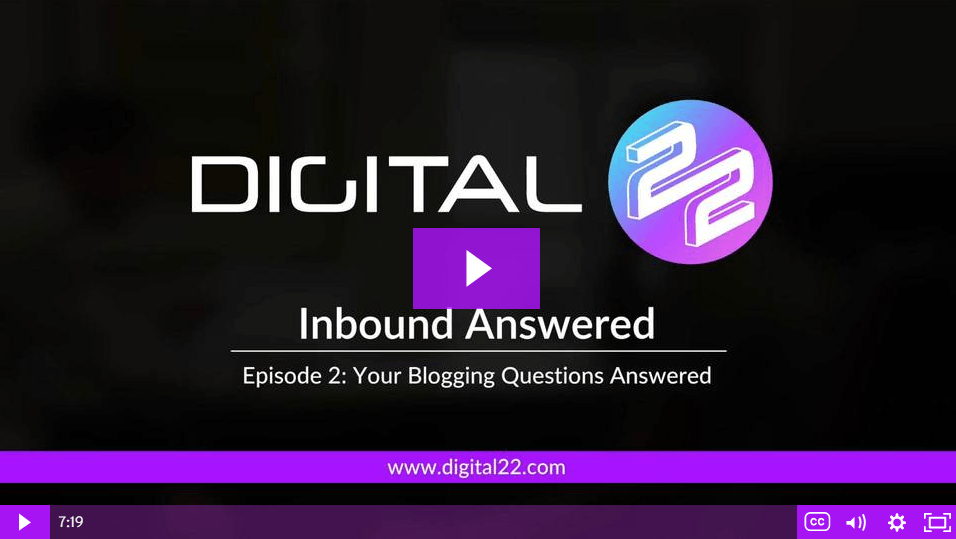“Work from home if you can.” This was the advice from the Prime Minister around two weeks ago....
Inbound Marketing blogging can help you get more customers, it really is as simple as that. Although, there’s a difference between regularly blogging and knowing the relevant steps to take to set it up for great success so more eyes can get on it. The Inbound blogging process is different from how regular writers will blog. So here’s a handy checklist to keep on hand for when you next blog.

Before you decide to pass on your blog for somebody else to proofread or even publish, follow the steps below:
- Answer the Question Right Away and Throughout
- Add Value in Every Paragraph
- Solve At Least One Pain Point
- Empathise and Speak Directly to Your Persona
- Check the Word Count and Errors
- Don’t Forget the Meta Description and Optimisation
- Select an Engaging Featured Image
- Make Sure the CTA is Correct
- A Logical CTA Lead-in
- Include Internal and External Links
Just click on any of the points above to learn more about why each point matters for when you blog.
1. Answer the Question Right Away and Throughout
Put yourself in the shoes of your readers. If you have a problem and you come across a blog that promises a solution in the title, you expect to get value right away and throughout the blog.
A huge mistake to avoid is to waffle on for the duration of the blog and offer very little value at the end of the blog. By that time, readers might either feel deceived or even exited the blog to find their answer elsewhere.
So, give them the answer from the first paragraph so their pain points are instantly catered to.
2. Add Value in Every Paragraph
Linking to the previous point, every paragraph in your blog post should add value and knowledge to the reader. There’s no benefit in adding filler paragraphs for the sake of stretching out a blog.
If there’s content there which you feel the readers will find knowledgeable and they will leave thinking they’ve learnt something, then include it. If not, don’t force it.
3. Solve At Least One Pain Point
The whole point of your blog posts is so that you can target your personas and solve their challenges. So when you’re planning or writing up your blog, make sure that you’re solving at least one of their pain points.
Again, the readers are looking for a solution to the problems they’re having. If you’re able to regularly solve pain points then you’ll become a trustworthy source. It’s a double win. It’s just like this blog, you’re here to find out the steps you can take when creating a blog - and we’re giving you the answer.
4. Empathise and Speak Directly to Your Persona
Persona knowledge is vital here, regardless of how many clients you’re writing for. You need to know who you’re catering your content for, how much free time they have to read a blog, their challenges, the language you should be using and so on.
By having that persona knowledge, you’ll be in a better position to tailor your content around them to empathise with readers - regardless of their job role.
5. Check the Word Count and Errors
It might sound like a simple step, but it’s vital that you never overlook it. Although there’s no official rule on the word count, don’t force thousands of words into a blog for the sake of it. Be smart with your word count and find a balance that can be quick enough for a user to read yet still offer plenty of value.
Checking for errors in your blog should be something that’s seen as a process during your blog writing. We can’t emphasise just how important this step is to weed out all of the errors that can creep through. Mistakes can drop the value of a blog and it doesn’t reflect well on you or your company. Don’t just read through it once either - or get another set of eyes to check through.
6. Don’t Forget the Meta Description and Optimisation
Your blogs’ meta description not only needs to be relevant but also optimised to the extent where you’re able to actually rank on search engines like Google. For example, there’s a character limit you need to consider and how to include keywords.
It needs to be enticing enough for somebody to click on your blog when they find it on a search engine. If it’s optimised effectively and meets the guidelines, then you’ve got a much better shot of landing on the first page of Google.
7. Select an Engaging Featured Image
This is another simple step that doesn’t get enough importance. Nobody is tempted to click on a pixelated image that has no correlation to the blog topic, are they? Think about your blog topic and search for a high-resolution image that fits your blog.
Make sure you’ve checked that you’ve credited the image (even if it’s from a stock website), make sure it’s appropriate to use and ask yourself if you’d click to read the blog based off the image alone.
8. Make Sure the CTA is Correct
The point of your blog post is to get your readers to take action. That’s right at the bottom with your CTA and a big mistake to avoid is sticking any random CTA you can find. That can actually drive readers away more than getting them to stick around.
It’s important to think about the type of CTA to use at the end of your blog. Take this one for example, you wouldn’t expect to see a pricing guide or a Growth Driven Design CTA to click on. You’re expecting more information on blogs and a handy checklist to keep with you.
9. A Logical CTA Lead-in
While the actual CTA itself in your blog needs to relate to the content, the lead-in to that CTA needs to flow naturally. Think about how you will logically lead into the CTA at the bottom of the blog without it sounding like an obvious jump from your final point to the CTA.
That will sound abrupt and throw your readers off.
10. Include Internal and External Links
Finally, make sure you’re further optimising your blog by adding both external and internal links. The latter is the perfect opportunity to link to your other blogs and build further authority and it also helps other relevant blogs get some traffic too.
External links are just as important. Your readers can only trust you so much and linking to industry leaders to show statistics and studies further show you’re an expert.
Grab Your Free Inbound Blog Checklist
There’s still a lot more you can add in your blog checklist, but the above is a great process to implement. Go ahead and download it to learn a little more about each step or even keep this handy checklist on you at all times.



